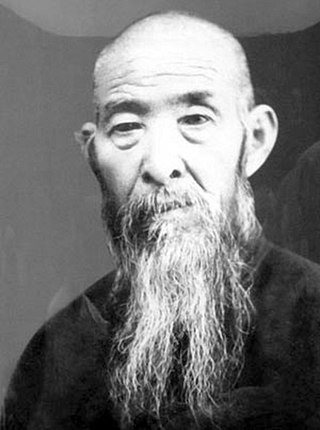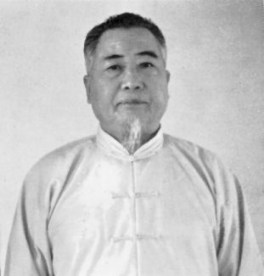Related Research Articles

Neijia is the collective name for the internal Chinese martial arts. It relates to those martial arts occupied with spiritual, mental or qi-related aspects, as opposed to an "external" approach focused on physiological aspects. The distinction dates to the 17th century, but its modern application is due to publications by Sun Lutang, dating to the period of 1915 to 1928. Neijing is developed by using neigong or "internal changes", contrasted with waigong or "external exercises".

Tai chi is an internal Chinese martial art practiced for self-defense and health. Known for its slow, intentional movements, tai chi has practitioners worldwide and is particularly popular as a form of gentle exercise and moving meditation, with benefits to mental and physical health.

Cheng Man-ch'ing or Zheng Manqing was a Chinese expert of tai chi, Chinese medicine, and the so-called three perfections: calligraphy, painting and poetry. He was born in Yongjia, Zhejiang Province, during the Qing dynasty. Cheng died March 26, 1975; his grave is near the city of Taipei in Taiwan.

In Chinese philosophy, taiji is a cosmological state of the universe and its affairs on all levels, involving the interaction of Yin and Yang, the Five Phases and finally, all the concrete things in the universe. More concretely, taiji is a conceptual current throughout religious and philosophical traditions indigenous to China, contemperaneously studied and applied in the profession of acupuncture, and within traditional Chinese medicine throughout and beyond the Sinosphere.

The Sun-style tai chi is one of the five primary styles of tai chi. It is well known for its smooth, flowing movements which omit the more physically vigorous crouching, leaping and fa jin of some other styles. Its gentle postures and high stances make it very suitable for martial arts therapy.

Wu Jianquan was a famous teacher and founder of the neijia martial art of Wu-style tai chi in late Imperial and early Republican China.

Sun Lutang (1860-1933) was a master of Chinese neijia (internal) martial arts and was the progenitor of the syncretic art of Sun-style tai chi. He was also considered an accomplished Neo-Confucian and Taoist scholar, and was a distinguished contributor to the theory of internal martial arts through his many published works.
Huang Sheng-shyan or Huang Xingxian was a Chinese martial artist. He was a practitioner and promoter of the art of tai chi.
Neigong, also spelled nei kung, neigung, or nae gong, refers to a series of internal changes that a practitioner goes through when following the path to Dao, and these changes may be achieved through practices including qigong or tai chi. Neigong is also associated with xingyi quan.

Yang Jianhou (1839–1917), or Yang Chien-hou, was the younger son of the founder of Yang-style tai chi, Yang Luchan, and a well known teacher of the soft style martial art of tai chi. Yang's older brother, Yang Banhou, was the senior of Jianhou's generation, and also an important instructor of tai chi. Yang Jianhou's sons Yang Chengfu and Yang Shaohou were also famous teachers of tai chi.
Tchoung Ta-tchen or Zhong Dazhen was a martial arts teacher who developed his own version of Yang-style tai chi. He died on February 22, 2000.

Wu Quanyou was an influential teacher of tai chi in late Imperial China. His son is credited as the founder of the Wu-style tai chi. As he was of Manchu descent, and would have been named by his family in Manchu, the name "Wú" (吳) was a sinicisation that approximated the pronunciation of the first syllable of his Manchu clan name, U Hala.

Wu Daqi or Wu Ta-ch'i (1926–1993) was the descendant of the famous Wu-style tai chi founders Wu Quanyou (1834–1902) and Wu Jianquan (1870–1942). He directed Wu-style tai chi instruction outside of Mainland China after the death of his father Wu Gongyi (1900–1970) and brother Wu Ta-kuei (1923–1972) from the Wu-style tai chi headquarters in Hong Kong internationally.
Taijijian is a straight two-edged sword used in the training of the Chinese martial art tai chi. The straight sword, sometimes with a tassel and sometimes not, is used for upper body conditioning and martial training in traditional tai chi schools. The different family schools have various warmups, forms and fencing drills for training with the jian.
Chen Weiming (1881–1958) was a scholar, tai chi teacher, and author. He was also known by his name Chen Zengze (陳曾則), Weiming being his hao, a pen-name.

Robert William Smith was an American martial artist and writer, most noted for his prodigious output of books and articles about the Asian martial arts and their masters. Smith's writing was an important factor in the spread of Asian martial arts such as judo, baguazhang, xingyiquan, and tai chi in the postwar United States.

The tai chi classics are a collection of over 100 articles on the Chinese martial art of tai chi written by the art's master practitioners over the centuries. They cover everything from the underlying taiji philosophical principles, to methods of practice and application. Previously passed down in secret from generation to generation in whole or in parts through various lineages, they achieved classical status as they became public starting in the mid-1930s. Together they now serve as the single authoritative guide for the development and usage of tai chi skills. Written mostly in classical Chinese, they are used today mostly by the serious martial art practitioners of modern 6 Lineages that all trace their lineages to the ancient style taught by the Chen family and Yang family starting in the mid-19th century.

Chang Dsu Yao was a teacher of the martial arts Meihuaquan and tai chi.

Yang Luchan, also known as Yang Fukui (1799–1872), was an influential Chinese practitioner and teacher of the internal style tai chi. He is known as the founder of Yang-style tai chi, the most popular and widely practised tai chi style in the world today.

Wu-style tai chi is one of the five main styles of tai chi. It is second in popularity after Yang-style, and the fourth-oldest of the five major tai chi styles. It was developed by Wu Quanyou and Wu Jianquan.
References
- 1 2 Davis, Donald D.; Mann, Lawrence L. (1996). "Conservator of the Taiji Classics: An Interview with Benjamin Pangjeng Lo" (PDF). Journal of Asian Martial Arts. 5 (4). ISSN 1057-8358. OCLC 920388667. Republished in DeMarco, Michael A.; LaFredo, T. G., eds. (2015). "Conservator of the Taiji Classics: An Interview with Benjamin Pangjeng Lo". Cheng Man-ch'ing and T'ai Chi: Echoes in the Hall of Happiness. Santa Fe, NM, US: Via Media Publishing. pp. 148–162. ISBN 978-1893765061.
- ↑ Davis, Barbara (18 October 2018). "In Memory: Benjamin Lo". Taijiquan Journal. Retrieved 20 February 2022.
- ↑ Chen, David (2001). "Five principles of good Tai Chi Ch'uan skills, and interview with Mr. Benjamin Lo of San Francisco". Wuwei Tai Chi Club. Retrieved 20 February 2022.
- ↑ Smith, Robert (1999). "Ben Lo: Modest Man, True Taiji" . Martial Musings: A Portrayal of Martial Arts in the 20th Century. Erie, PA, US: Via Media Publishing Company. p. 296. ISBN 978-1-893765-00-9. OCLC 1285659619 – via Internet Archive.